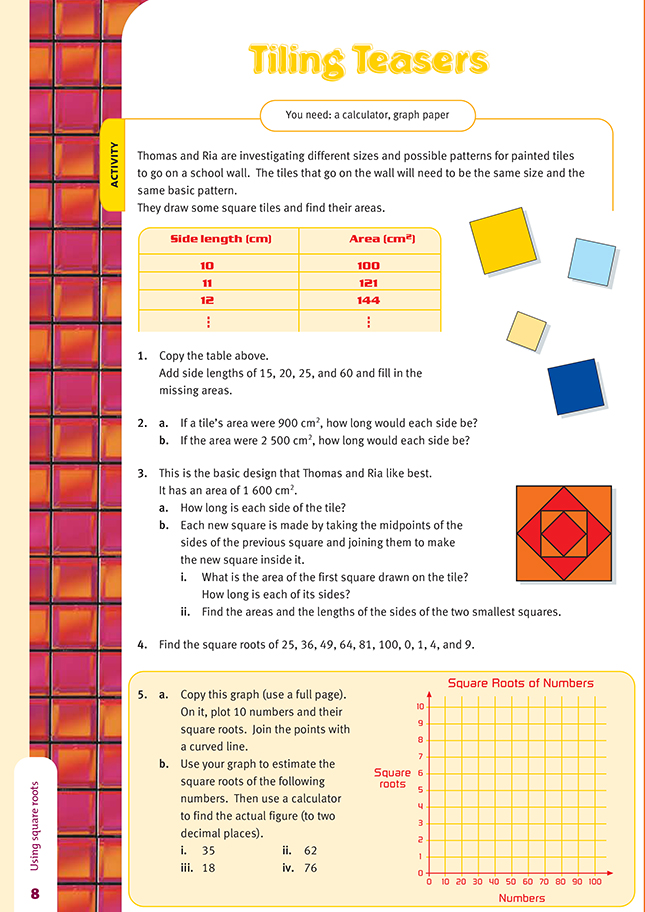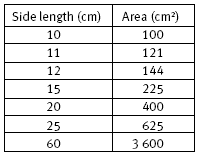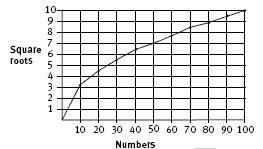This is a level 5 number activity from the Figure It Out series. It relates to Stage 8 of the Number Framework.
A PDF of the student activity is included.
Click on the image to enlarge it. Click again to close. Download PDF (175 KB)
solve problems involving sqaure roots
Calculator
FIO, Level 4+, Number, Book Six, Tiling Teasers, page 8
Graph paper
The students need to be comfortable finding the area of a square and working with square roots in order to do this activity.
Question 1 provides a basis for question 2, which some students will be able to calculate mentally. Those who can’t, could use √ the key on their calculator. Question 3 is where the real challenge begins, although 3a can be figured out in the same manner as question 2.
For question 3b i, some students may work out the length of each side of the first inner square on the tile by using Pythagoras’ theorem that the sum of the squares on two sides of a right-angled triangle is equal to the square of the hypotenuse. Other students will probably work out that the first inner square is actually half the area of the whole tile. You could help them to understand this by dividing the whole tile
into quarters and imposing the first inner square on this or by folding a square of paper in at the corners. Similarly, they may be able to see that the second inner square is one-half of the area of the first inner square or one-quarter of the area of the whole tile, and that the area of the smallest inner square is half that of the previous one. In other words, the area keeps halving as the squares get progressively
smaller.
The students can then find the length of the sides of the squares by finding the square root of the area of each square. For example, the side lengths of the square with an area of 800 cm2 are each √800, which is 28.3 (to one decimal place).
Alternatively, some students may calculate the length of the sides of the first inner square by using Pythagoras’ theorem, based on the calculation that the sides of the whole tile are each 40 centimetres in length. The students may notice that one side of this first inner square is actually the hypotenuse of the triangle in the outer corner of the tile. Thus, the length of the hypotenuse is the square root of 202 + 202, which is
√(400 + 400) = √800, which is 28.3 centimetres to one decimal place. The students can then use logical reasoning to figure out that the length of the sides of the smallest inner square is just half that of the first inner square (that is, 14.14 centimetres or 14.1 to one decimal place) and that the length of the sides of the second inner square is half that of the tile itself (that is, 20 centimetres).
In question 4, the students will find it easier if they draw a fairly large graph of the data shown so that the estimates required in 4b are more manageable. As well as using their graph to estimate the square roots, they can estimate by finding the nearest square number. For example, 35 is close to the square number 36, and the square root of 36 is 6, so the square root of 35 will be a little less than 6. They can then use a calculator to find the actual square root.
Answers to Activity
1.
2. a. 30 cm
b. 50 cm
3. a. 40 cm
b. i. area: 800 cm2
side lengths: 28.3 cm (1 d.p.)
ii. The second smallest square has an area of 400 cm and side lengths of 20 cm.
The smallest square has an area of 200cm2 and side lengths of 14.1 cm (1 d.p.).
4. 5, 6, 7, 8, 9, 10, 0, 1, 2, and 3
5. a. Points will vary, depending on the numbers chosen.
An example is:
b. i. Estimates may vary.
Actual square root: 5.92 (2 d.p.)
ii. Estimates may vary.
Actual square root: 7.87 (2 d.p.)
iii. Estimates may vary.
Actual square root: 4.24 (2 d.p.)
iv. Estimates may vary.
Actual square root: 8.72 (2 d.p.)
Note: Other sensible rounding or truncating solutions are also acceptable. Check with your teacher.



